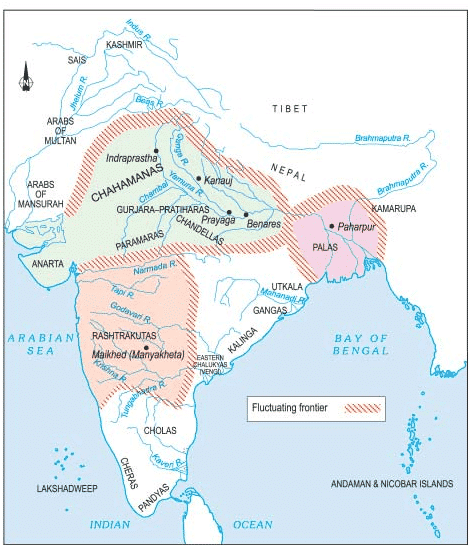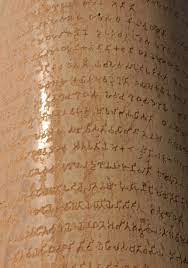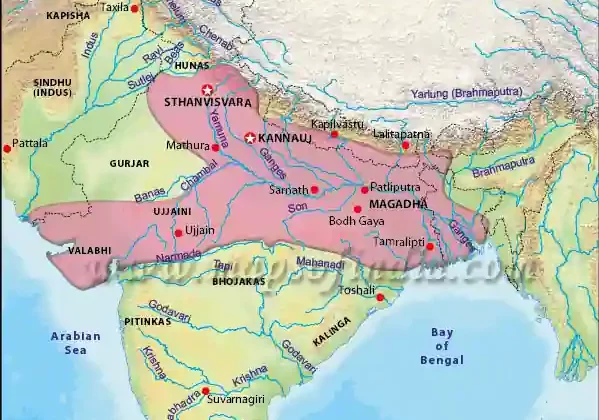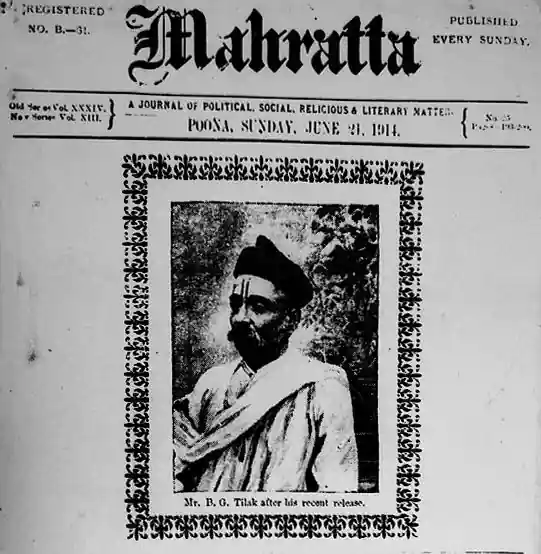About Buddhism
Buddhism originated as an alternative tradition to the excessive importance given to rituals and sacrifices in the Vedic tradition. It was also a reaction to the gross neglect of the social problems of the time, as well as a revolt against the hegemony of the Brahmins in society.

- Buddhism is the state of perfect enlightenment attained by a Buddha. The perfect enlightenment is sammāsambodhi in Pali.
- The Buddhavamsa mentions 29 Buddhas in all. The 27 Buddhas, preceded Gautam Buddha and Maitreya, the 29th Buddha is next to come in the future.
- It was a time of two extremes: the Vedic, Upanisadic belief in the Absolute supported by sacrifices, rituals (yajnas) and the materialistic philosophy of the Charvaka.
- Buddha avoided and negated the extremes, and at the same time integrated the positive elements of these two systems.
- He negated the existence of the soul and the Absolute, but he accepted the belief in the law of karma and the possibility of attaining liberation.
- His main concern was the welfare of the ordinary people. Though Buddha himself wrote nothing, the early writings were in the Pali and Sanskrit languages.
The main causes for the emergence of Buddhism
- Social: A Brahmin-centered, caste-based, hierarchical setup was prevalent in the society. The authority to interpret the scriptures was vested with the Brahmin. Temples, which were the centers of social life, were controlled by them. Laws of pollution were strictly imposed upon the people of the lower caste. Tribes and Dravidians were out of the caste structure.
- Economic: Agriculture and cattle rearing were the main source of wealth and livelihood for the people. Brahmins found out ways and means to exploit the lower sections in the society. Kings were made to perform yagas, yajnas, and digvijayas through which the Brahmins benefited a lot. The ordinary people had to contribute a major portion of their income to the kings, Brahmins, and temples.
- Religious: Mode of worship, rituals, and religious ceremonies were interpreted by the Brahmins to suit their interest. The Vedas, Aranyakas, Mimamsas and Upanishads were written to perpetuate the hegemony of the Brahmins. Metaphysical speculations were at their zenith, which was the prerogative of the educated class. Exploitation by the higher castes and the suffering of the ordinary people continued unabated.
Life of Gautam Buddha
FOUR NOBLE TRUTHS
The Buddha was least interested in metaphysical discourses or dogmas. He was concerned about ethical living, applicable to all sections of people – kings, princes, Brahmans, people of low caste, masters, servants, monks, ordinary people, etc. He taught about the nobility of a religion. The four Noble Truths are the essence of the Buddha’s teachings, which he explained in his first sermon to his old colleagues at Isipattana. These noble truths are explained in detail later, in other early Buddhist scriptures.
- Dukkha: there is ‘Suffering’ in the world.
- Samudaya: the arising or origin of ‘Suffering’.
- Nirodha: the cessation of ‘Suffering’.
- Magga: there is a path leading to the end of ‘Suffering’.
THE DOCTRINE OF NO SOUL (ANATTA)
- Almost all religions accepted the existence of a soul, whereas materialism strongly rejected the existence of a soul. Buddhism did not follow any of the prevalent trends but followed the middle path. Buddhism was an exception, in denying the existence of a soul, but at the same time, it rejected the materialistic philosophy. The idea of an ego or a self in any religion is with the aim of self-protection and self-preservation. Self-protection necessitates the existence of God, and self-preservation necessitates the existence of self. These two are basically selfish desires.
- The concept of anatta, or anatman, is a departure from the Hindu belief in atman (“the self”). Anatman is more accurately described as a strategy to attain non-attachment by recognizing everything as impermanent, while staying silent on the ultimate existence of an unchanging essence.
CONCEPT OF NIRVANA
- The concept of Nirvana in Buddhism is entirely different from Hinduism.
- Buddhism denied the concept of Moksha.
- However, it defines Nirvana has to get rid of the Cycle of Death and birth.
- It is achieved in life itself and not after death. To achieve nirvana one should follow a moral code of Conduct.
THE CONCEPT OF GOD
- Almost all the sects of Buddhism do not believe in the myth of God. Indeed some of the early Indian Mahayana philosophers denounced God-worship in terms that are even stronger than those expressed in the Theravada literature.
- Some later Mahayana schools, which flourished outside India, ascribed some degree of divinity to a transcendent Buddha, considering living Buddhas to be a manifestation of the Adi Buddha.
- But even then it cannot be said that the Buddha was converted into a divinity comparable to the God of the monotheistic religions.
- In the Brahmajala Sutta and the Aggaa Sutta texts, the Buddha refutes the claims of Maha Brahma (the main God) and shows him to be subject to karmic law (i.e. cosmic law). Even long-lived Maha Brahma will be eliminated in each cycle of inevitable world dissolution and re-evolution.
- In the Khevadda Sutta, Maha Brahma is forced to admit to an inquiring monk that he is unable to answer a question that is posed to him, and advises the monk to consult the Buddha. This clearly shows that Brahma acknowledges the superiority of the Buddha. The Buddha is viewed as some kind of a god figure.
- In the Theravada tradition, the Buddha is regarded as a supremely enlightened human teacher who has come to his last birth in the samsara (the Buddhist cycle of existence).
- But, Mahayana traditions, which tend to think in terms of a transcendental Buddha, do not directly make a claim for Buddha as God.
- Thus the Buddha cannot be considered as playing a God-like role in Buddhism. Rather, Buddha is concerned as an enlightened father of humanity.
TRIRATNA OF BUDDHISM
The ideals, at the heart of Buddhism, are collectively known as the Triratna (‘Three Jewels’, or the ‘Three Treasures‘). These are:
- Buddha (The Yellow Jewel) – The enlightened
- Dhamma (The Blue Jewel) – Doctrine of Buddhism
- Sangha (The Red Jewel) – Order of Buddhism
TEACHINGS BY BUDDHA
- Buddha was a practical reformer. He did not believe in soul or god or metaphysical world & concerned himself with the worldly problems.
- Suggested that a person should avoid an excess of both, Luxury & Austerity & prescribed a middle path
- Laid great emphasis on Karma (based on action not on birth) & Ahimsa
- Opposed the varna system & laid down the principle of social equality
SPREAD OF BUDDHISM
- Buddhism had 2 kinds of disciples – Monks (Bhikshus) & Lay worshippers (Upasikas).
- Monks were organized into sangha for the purpose of the spread of Buddhist teachings.
- Membership was open to all, male or female without any caste distinction, but every member had to take a vow of continence, poverty & faith (Penance to achieve liberation).
- Use of Pali language also contributed to the spread of Buddhism.
- Vijaya Singhava was the first to preach Buddhism in Ceylon.
- Kumarajeeva was the first to introduce Buddhism in China.
- Kanishka made it popular in Central Asia.
- Minandar – An Indo-Greek was converted into Buddhism by Nagasena.
- The dialogue between Minandar & Nagasena is recorded in Milindopanha (a text in Pali).
- Kumargupta of Gupta dynasty founded Nalanda University (University of Buddhist studies).
- Harsha Vardhana – the last great king of ancient India, was converted into Mahayana Buddhism by Huien Tsang. Harsha conducted Buddhist conferences called Sangeethies at Prayag.
- The Palas were the last patrons of Buddhism. They founded three universities: Vikramshila (Attesha Deepankar was the first VC), Uddandapura and Jagaddala.
- Palas patronized Vajrayana Buddhism (Buddhism with Mantra & Tantra and magical powers) In the South, Acharya Nagarjuna founded Sree Parvatha University in Nagarjunikonda.
BUDDHIST LITERARY TEXTS
The Tripitaka (called Tipitaka in Pali) is the earliest collection of Buddhist writings. Initially, the Composition of Three Basket was in oral and subsequently written down in the third century BC approximately. All the Pitakas (baskets) were written in Pali Language:
- Sutta Pitaka
- Vinaya-Pitaka
- Abhidhamma-Pitaka
The three Baskets divide themselves by subject matter:-
- Sutta Pitaka (Discourse (speak) Basket) contains records of the Buddha’s teachings and sermons. These discourses of the Buddha present matters of theology and moral behaviour for all Buddhists.
- Vinaya Pitaka (Discipline Basket), sets out the rules and guidelines for living the monastic life of the Sangha. It focuses first on the 227 regulations for monks (Bhikkhus / beggars), which concern everything from basic morality to robe making, the additional rules for the nuns (Bhikkhunis), and then on guidelines for interaction between the monks and nuns and the laity.
- Abhidhamma Pitaka (Special Teachings) is essentially a miscellaneous collection of short writings containing everything from songs and poetry to stories of the Buddha & his previous lives. One text, the Dharmapada, contains simple discussions of key Buddhist concepts based on the Buddha’s daily life.
- The Prakrit language that was used by Buddha was Pali. Upto the first century A.D., Prakrit remained the official language of Buddhists; after that literature in Sanskrit became prominent due to the influence of Mahayana Buddhism during the 4th Buddhist Council.
- Most important Pali Texts are Milandopanha, Suttapitaka, Vinayapitaka, Abhidammapitaka.
- The First Sanskrit scholar in Buddhism was Aswaghosa. He wrote ‘Buddha Charitra’. It is the first Kavya in Sanskrit literature. All the nine Rasas are there in it.
- Sundaranandana and Seriputraprakarana, found in Khotan in Central Asia, are the other prominent Buddhist texts.
- The most important/Greatest Scholar of Buddhism was Acharya Nagarjuna (The Einstein of India). Nagarjuna was a friend and contemporary of Satavahana king Yajnasri Gautamiputra of Andhra. He propounded the Madhyamika school of Buddhist philosophy popularly known as Sunyavada. He wrote the following treatises:
- Madhyamika Siddhanta)
- Madhyamika Sutralankara Buddhist Philosophy
- Saddharma Pundareeka
- Stuhul Lekha was a letter by him to his friend King Yagnasri Satakarni (of Satavahanas).
- Rasarainakara which deals with chemical properties.
- Vasubandhu was the author of Abhidhammakosa (First dictionary on Buddhist philosophy).
- Amarakosa – written by Amarasimha is the first dictionary in Sanskrit.
- Dignaga was the first to introduce the theory of logic (Tarkashastra) in India. He is also called ‘Kant of India’ and he wrote Pramanasamuchchaya.
- Buddhaghosa – wrote Vasuddimaga (Contribution of Maga). He was the Commander of Chandragupta Vikramaditya II.
- Jataka stories in Sanskrit language numbering around 500, deal with previous births of Buddha called Bodhisattvas. They were entirely written by Mahayanis.
BUDDHIST COUNCIL
| Buddhist Council | Where | Chairman | Patron | Remarks |
| First (400BC) | Rajgir | Mahakashyap | Ajatasatru | Ananda composed Suttapitaka & Upali composed Vinaya Pitaka |
| Second (383BC) | Vaishali | Sabakami | Kalasoka | Mainly due to 10 disputed points under Vinaya Pitaka |
| Third (250BC) | Patliputra | Mogliputta Tissa | Ashoka | Compilation of Abhidhamma Pitaka took place |
| Fourth (72AD) | Kundalvana, Kashmir | Vasumitra | Kanishka | Resulted in the division of Buddhism into Hinayana & Mahayana |
1st Buddhist Council (400 BC)
- It was held immediately after the death of Buddha at Saptaparni cave in which the unwritten teachings of Buddha were penned down after his death.
- Held at Rajgir under the patronage of Ajatasatru under the chairmanship of Mahakashyap.
- Ananda composed Suttapitaka (Buddha’s Teachings) & Upali composed Vinaya Pitaka (Monastic code for Buddhism).
2nd Buddhist Council (383 BC)
- It was held at Vaishali.
- It was held at approx. 100 years after the death of Buddha under the patronage of King Kalasoka under the chairmanship of Sabakami.
- Mainly due to 10 disputed points under Vinaya Pitaka (Monastic codes of Buddhism). The dispute was on 10 Points such as storing salt in the horn, eating after midday, eating once and going to villages for alms, eating sour milk after one’s meal, etc.
3rd Buddhist Council (250 BC)
- Held under the patronage of Ashoka under the chairmanship of Mogliputta Tissa.
- Compilation of Abhidhamma-Pitaka took place (Philosophical exposition of Buddhism)Buddhism preached & propagated by Ashoka is known as Hinayana.
4th Buddhist Council (72 AD)
- It was held under the patronage of Kanishka under the chairmanship of Vasumitra.
- This resulted in the division of Buddhism into Hinayana & Mahayana.
- Asvaghosa participated in this council & all the deliberations were made in Sanskrit.
CONTRIBUTION OF BUDDHISM
- The earliest Buddhist text “Sutta Nipata” pleads for protection of cattles & helped to prevent their decimation
- Taught people to put reason in everything & pleaded for logic instead of superstitions hence promoted rationalism among people
- Promoted education through residential universities like Valabhi, Nalanda & Vikramashila
- Formed Hybrid Sanskrit by a mixture of Pali & Sanskrit
CAUSE OF DECLINE
- The revival of Brahmanism & rise of Bhagavatism
- Use of Sanskrit instead of Pali from 4th Buddhist council (Around 100 AD)
- After the birth of Mahayana, the Practice of Idol worship, huge offerings & donations became common & led to the deterioration of moral standards
- The attack of Hunas (Around 500 – 600 AD) & Attack of Turkish invaders (1200 AD) destroyed major Buddhist Monasteries
- Brahmana ruler Pushyamitra Shunga was a great persecutor of Buddhists
- Shaivite Shashanka is said to have cut the original Bodhi tree at Bodhgaya
Also, refer :
- Difference Between Hinayana, Mahayana And Vajrayana Buddhism
- Prominent Personalities Associated With Buddhism
- ARHATS Under Theravada And Mahayana Buddhism
- Symbols Of Five Great Events Of Buddha’s Life
- Know About The Top 10 Disciples Of Buddha
- Important Buddhist Pilgrimage Sites
- Places Associated With Buddha’s Life And Buddhism
- The Concept Of Bodhisattva In Buddhism
- Important MCQs From the History Of Ancient India








